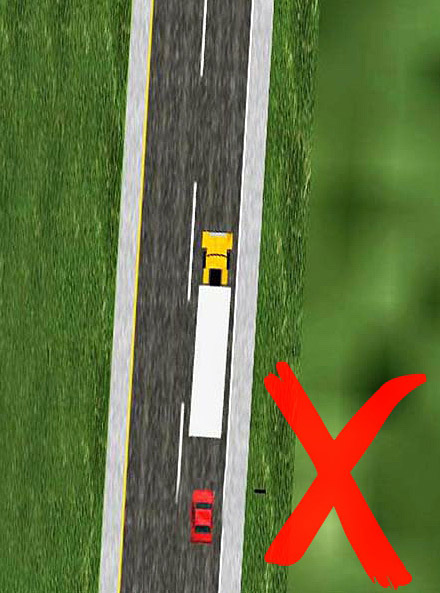The rear blind spot, or no-zone, is located behind the trailer of the truck. The rear no-zone extends nearly 200 feet from the back of the truck, which is roughly the length of half a football field. If you are any closer than this to the back of a truck, then you are following too closely and are essentially invisible to the truck driver.
Rule of thumb: look for the truck's mirrors as you are following. Ideally, you want to be far enough back to see the mirrors on both sides of the truck. At a minimum, you should see the mirrors on the left driver's side.
Following too closely behind a truck is dangerous for several reasons. Most importantly, you want to leave yourself plenty of time to react should the truck need to make sudden changes. While this applies to following behind any vehicle, it is especially important with large trucks. Since they are so big, you have no idea what's in front of the truck on the road ahead. If the truck driver passes over debris on the road, such as a truck tire, you won't see it in time to avoid hitting it. Secondly, trucks carry cargo that may come loose and fall from the truck onto the road. If you're following too closely, you are not leaving yourself enough space or time to avoid colliding with anything that falls in front of you. Finally, by following too closely to the back of a truck, you cut off your own view of the traffic flow ahead. If the truck driver needs to brake suddenly—for instance, if another driver cuts in front of the truck—you won't have enough time and space to avoid crashing into the back of the truck.


Crashing into the back of a truck results in a specific type of crash called an “underride,” where the front end of the car gets wedged under the rear of the truck's trailer. This type of crash can be especially dangerous if the truck isn't equipped with an adequate underride guard, as the bottom rear of the trailer is about head-level for an adult seated in a car. This means the only thing between your head and the rear of the trailer is the car's windshield, which will obviously provide zero protection from such an impact.
This is not a situation you want to find yourself in, so stay back!
Unlike the other clips on this website, this clip was filmed on the test track at VTTI to specifically show a car following a truck too closely. The first view in the clip is from the car driver's perspective. Neither of the truck's side mirrors are visible to the car driver, so it's clear they are following too closely. At this distance and speed, it would be nearly impossible to react in time to avoid any obstacles on the road or cargo falling off the back of the truck. The next view in the clip is from the back of the truck's trailer. From this view it's easy to see how quickly the car driver would need to react to avoid a rear-end crash if the truck was to stop suddenly. The car driver leaves themself no room for recovery if something unexpected were to occur. Remember, unexpected things happen all the time on the roads. By giving yourself some space between you and the back of the truck in front of you, you avoid putting yourself in a dangerous situation. Following a truck too closely accomplishes absolutely nothing, so it isn't worth the risk!